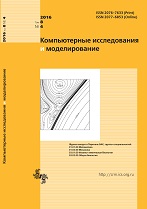|
SOLVING INDUSTRIAL PROBLEMS IN DEFORM SOFTWARE
Simulation of forming of UFG Ti-6-4 alloy at low temperature of superplasticity
N. V. Lopatina, E. A. Kydrjavtsevb, P. V. Paninc, S. V. Vidumkinac
a CMK JSK,
2 Pristantsionnaya st., Stupino, Moscow Region, 142800, Russia
b Belgorod State National Research University,
85 Pobedy st., Belgorod, 308015, Russia
c All-Russian Scientific Research Institute of Aviation Materials,
17 Radio st., Moscow, 105005, Russia
Abstract:
Superplastic forming of Ni and Ti based alloys is widely used in aerospace industry. The main advantage of using the effect of superplasticity in sheet metal forming processes is a feasibility of forming materials with a high amount of plastic strain in conditions of prevailing tensile stresses. This article is dedicated to study commercial FEM software SFTC DEFORM application for prediction thickness deviation during low temperature superplastic forming of UFG Ti-6-4 alloy. Experimentally, thickness deviation during superplastic forming can be observed in the local area of plastic deformation and this process is aggravated by local softening of the metal and this is stipulated by microstructure coarsening. The theoretical model was prepared to analyze experimentally observed metal flow. Two approaches have been used for that. The first one is the using of integrated creep rheology model in DEFORM. As superplastic effect is observed only in materials with fine and ultrafine grain sizes the second approach is carried out using own user procedures for rheology model which is based on micro-structure evolution equations. These equations have been implemented into DEFORM via Fortran user’s solver subroutines. Using of FEM simulation for this type of forming allows tracking a strain rate in different parts of a workpiece during a process, which is crucial for maintaining the superplastic conditions. Comparison of these approaches allows us to make conclusions about effect of microstructure evolution on metal flow during super-plastic deformation. The results of the FEM analysis and theoretical conclusions have been approved by results of the conducted Erichsen test. The main issues of this study are as follows: a) the DEFORM software allows an engineer to predict formation of metal shape under the condition of low-temperature superplasticity; b) in order to augment the accuracy of the prediction of local deformations, the effect of the microstructure state of an alloy having sub-microcristalline structure should be taken into account in the course of calculations in the DEFORM software.
Keywords:
DEFORM, forming, UFG titanium alloy Ti-6Al-4V.
Received: 22.02.2016
Revised: 21.03.2016
Accepted: 13.04.2016
Citation:
N. V. Lopatin, E. A. Kydrjavtsev, P. V. Panin, S. V. Vidumkina, “Simulation of forming of UFG Ti-6-4 alloy at low temperature of superplasticity”, Computer Research and Modeling, 9:1 (2017), 127–133
Linking options:
https://www.mathnet.ru/eng/crm53 https://www.mathnet.ru/eng/crm/v9/i1/p127
|

| Statistics & downloads: |
| Abstract page: | 235 | | Full-text PDF : | 87 | | References: | 24 |
|




 Contact us:
Contact us: Terms of Use
Terms of Use
 Registration to the website
Registration to the website Logotypes
Logotypes







 Citation in format
Citation in format 